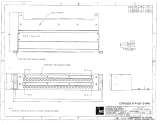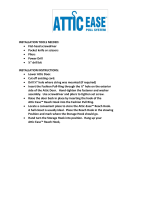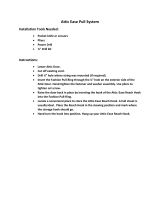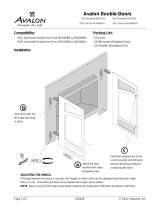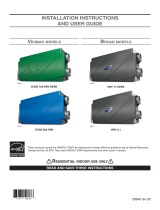Page is loading ...

AIR EXCHANGER model:
EA 20200, PRO 100, PRO 200
VENMAR
VENTILATION inc.
®
IMPORTANT ADVICE TO CONSUMERS
This box contains the ventilation system and the wall control. In order to complete the system and
its installation, you have to get another box which contains the installation parts. To
assure your entire satisfaction, Venmar’s engineers have developed and tested this
system with its original parts. We use top quality parts in order to guarantee you the
optimum efficiency of this system. Other brand parts are not approved by Venmar and
do not comply with our quality standards. Venmar accepts no responsibility regarding product
efficiency when installed with other parts than Venmar.
TABLE OF CONTENTS
1 Warranty . . . . . . . . . . . . . . . . . . . . . . . . . . . . . . . . . . . . . . 1
2 Operational principles . . . . . . . . . . . . . . . . . . . . . . . . . . . 1
3 Wall control . . . . . . . . . . . . . . . . . . . . . . . . . . . . . . . . . . . 2
4 Maintenance . . . . . . . . . . . . . . . . . . . . . . . . . . . . . . . . . . 4
5 Warning . . . . . . . . . . . . . . . . . . . . . . . . . . . . . . . . . . . . . . 4
6 Troublshooting . . . . . . . . . . . . . . . . . . . . . . . . . . . . . . . . . 5
7 Installation . . . . . . . . . . . . . . . . . . . . . . . . . . . . . . . . . . . . 5
USER'S MANUAL
Read and save these instructions
050397 - 01506
Venmar Quality Assuranc
Assurance Qualité Venm
a
Qualité Venmar

1 2
The ventilation systems from VENMAR VENTILATION inc. are high-quality
products manufactured and packaged with great care. The length of the
warranty is specified in your warranty document included with your unit. If
an operational defect occurs and cannot be resolved by reading this man-
ual, then we urge you to observe the following rules.
RULES TO FOLLOW: If the unit is defective, call our nearest service cen-
tre (list included). Be sure to write down the serial number before calling.
This can be found on the sticker placed on the side of the unit. Our service
personnel will determine with you the reason for the defect and will help you
find a solution to your problem. Call VENMAR VENTILATION inc. at 1-800-
567-3855 if you don't succeed in contacting a service centre.
BILL OF PURCHASE: All repairs or replacements covered by the war-
ranty require the original bill of purchase. Please retain your original.
MISCELLANEOUS COSTS: In each case, costs for the removal and
installation of the unit will be charged to the customer.
CONDITIONS AND LIMITATIONS: The above warranty applies to all
cases where the damage is not a result of poor installation, improper use,
mistreatment or negligence, acts of God, or any other circumstances
beyond the control of VENMAR VENTILATION inc. Any repairs carried out
without the supervision of VENMAR VENTILATION inc. will automatically
cancel the warranty. Furthermore, VENMAR VENTILATION inc. will not be
held responsible for any bodily injury or damage to personal property or
real estate, whether caused directly or indirectly by the ventilation system.
1
WARRANTY
3.1 IDENTIFICATION OF PARTS
A humidity level selector
B circulation selector
C symbol for “Intermittent Circulation”
D symbol for “Continuous Circulation”
3
WALL CONTROL
CIRCULATION WITH
AIR EXCHANGE:
While continually circula-
ting the air within the
house, the unit also evacu-
ates part of this stale air
and replaces it with fresh
dry air from the outside.
The following extra benefits
are thus obtained: lower-
ing of the humidity, elimina-
tion of stale air, cooling of
the house on hot summer
nights.
FILTRATION:
When the air flows through the system, a mechanical filter traps dust parti-
cles.
The air exchanger is designed to eliminate problems of excessive humidi-
ty, to steady the temperature and the humidity and to filter the air inside your
house. The air exchanger carries out the following operations:
AIR CIRCULATION:
(PRO 200 only)
The system circulates the
air inside the house, thus
steadying the temperature
and the humidity through-
out.
2
OPERATIONAL PRINCIPLES
FILTERED AIR
DISTRIBUTION
STALE AIR
FROM BUILD-
ING
STALE AIR
FROM
BUILDING
FRESH AIR TO
BUILDING
STALE AIR
TO OUTSIDE
FRESH AIR
FROM OUTSIDE
55%
10°
45%
0°
35%
EA20200 PRO 100
VENMAR
VENTILATION
inc.
1-800-567-3855
20
30
40
50
60
70
80
% RELATIVE HUMIDITY
% HUMIDITÉ RELATIVE
PRO 200
0FF
25
-30˚C
-20˚C
-5˚C
5˚C+
VENMAR
VENTILATION inc.
1-800-567-3855
20
30
40
50
60
70
80
% RELATIVE HUMIDITY
% HUMIDITÉ RELATIVE
0FF
25
-30˚C
-20˚C
-5˚C
5˚C+
A
B
C
D
%HUM. RELATIVE HUM EXT. TEMPS.°C EXT.
55%
10°
45%
0°
35%
%HUM. RELATIVE HUM EXT. TEMPS.°C EXT.
(PRO 200)(EA 20200 / PRO 100)

3 4
3.2 HOW TO USE THE WALL CONTROL
a) Using the humidity level selector:
Winter: (outside temperature between 5
o
C and -30
o
C)
- Position the selector between 50% and 25%, pointing approximately to
the corresponding outside temperature.
- If there is condensation or frost on the windows, then lower the humid-
ity level by 1 to 2% every 24 hours until
the condensation has evaporated.
- Do not go lower than 25%: the air will
become too dry for human comfort.
Spring and Fall:
- Position the selector anywhere between
75% and 50% (higher on warm days,
lower on cold days).
- If certain periods during the spring and
fall seem more like winter then you should
follow the instructions given for humidity
control during the winter!
Summer:
- Position the selector at 80% during the
day.
- If you want to introduce cool fresh air into the
house during certain summer nights, then lower
the selector to 20% for these nights.
b) Explanations about humidity levels: (IMPOR
TANT!)
The comfort level for human beings is between 30% and 45% relative
humidity. To measure the present humidity level in your house, you can
proceed as follows:
- turn the dial to 80%
- turn the dial slowly downwards until you hear a “click”. The dial will
then be pointing to the value for the present humidity level ( precision
of 5%).
Turning the selector lower than the “click” position means that you
desire to lower the humidity level in the house. This action will initiate the
“air exchange” mode on your ventilation system and means that you are
expecting the stale humid air from inside to be replaced with dryer air
from outside. It is therefore pointless to try and lower the humidity with
“air exchange” on rainy or foggy days.
Turning the selector higher than the “click” position means that you are
not interested in having your ventilation system function under “air
exchange” mode.
Finally keep in mind that the instructions given above are just guidelines.
You might prefer different values for the humidity selector, depending on
the insulation of your house, the type of windows, or to satisfy the specific
needs of certain occupants. After some experimenting, you will eventual-
ly develop a control method best adapted to your household needs.
c) Using the cir
culation selector (Model PRO 200 only)
- “Continuous Circulation”: At the exact moment when the desired
humidity level is reached, the “air exchange” mode is interrupted and
the system continues to operate under “circulation” mode only (see
section 2). The “air exchange” mode will be reactivated only if the
humidity level in the house goes up higher than the selected value.
- “Intermittent Circulation”: At the exact moment when the
desired humidity level is reached, the unit goes off. It will automatically
start up again in “air exchange” mode if the humidity level in the house
goes up higher than the selected value.
- Recommendations for a PRO 200 installed in the basement:
“Continuous Circulation” during the winter; “Intermittent Circulation”
during spring, summer, and fall.
- Warning: Adjust for “Continuous Circulation” during all 4
seasons if your unit is installed in the attic.
20%
60%
70%
0FF
25%
-30˚C
-20˚C
-5˚C
5˚C+
80%
50%
30%
40%
Air filter: We recommend that it be
cleaned
every three months
.
First, use a vacuum cleaner to
remove the accumulated dust.
Then wash it in warm soapy water.
Exterior openings:
Clean the exte-
rior intake and exhaust screens at
least
once a year
, preferably in
autumn.
4
MAINTENANCE
• Do not use your ventilation system when renovating a house or when
sanding gypsum. This type of dust may damage the unit.
• Do not use your ventilation system when varnishing. Furthermore, if your
unit is installed in the attic, we highly insist that you block the stale air
intake and fresh air registers. The varnish vapors may damage the unit.
• If your unit is installed in the attic, you should not turn it
"OFF" during the winter time in order to avoid condensation
inside the unit and inside the ducts.
5
WARNING

5 6
6
TROUBLESHOOTING
SYMPTOMS CAUSES SOLUTIONS
• Air too dry Humidity level Select humidity level
incorrectly selected according to section 3
• Persistant Humidity level Select humidity level
condensation incorrectly selected according to section 3 and
give the unit time to respond
Turn on the central heating
system
Too much firewood in Store the wood outside
the house
Air cannot circulate Do not completely close
close to windows curtains, blinds, etc.
Window frame too cold
• Air from Too much air exchange Install the white ring in the
distribution with the exterior fresh air intake port
register too cold
(section 7.4 )
6
7.1 INSTALLATION KITS
The opposite table indicates the instal-lation kits which are needed to cor-
rectly install your air exchanger.
Normally, the air exchanger is installed in the basement because it then
becomes easier to clean. The model PRO 200, however, can be installed
in the attic if a basement installation is impracticle. (Models EA 20200 and
PRO 100 should not be installed in the attic.)
When you have to install extra registers in the ground floor, use either: two
6" x 10" registers or three (4" x 10") registers.
We strongly recommend that you purchase VENMAR kits and registers.
Note: the parts contained in kits UT20003 and UT20004 are not suitable
for models PRO 100 and PRO 200.
7
INSTALLATION OF THE SYSTEM
YOUR HOUSE BASEMENT ATTIC
EA 20200
PRO 100 / PRO 200
PRO 200
BUNGALOW
basement
stairwell:
EA 20120 EA 20140 EA 20130
open, lateral
BUNGALOW
basement
stairwell:
EA 20120 EA 20140 EA 20130
closed
+++
2 or 3 2 or 3 2 or 3
COTTAGE
registers registers registers
basement
stairwell:
closed
BUNGALOW
basement
stairwell:
open, central
EA 20120
+
MULTI-
UT 20004
LEVEL
COTTAGE
basement
EA 20120
stairwell:
+
open
UT 20003

8
7
7.2 LOCATION OF COMPONENTS
It is necessary to carefully plan the location of all the components before
proceeding with the actual installation. The following suggestions will help
you to decide on the best location for each of the components.
Stale air intake r
egister:
Always locate the register at the highest point in the house, because humid-
ity is concentrated at this point.
Position the register as far from the stairway as possible and in such a way
that the air circulates in all the lived-in spaces in the house.
Avoid installing the register in a bathroom or a bedroom; place it in a location
where the air flows freely (eg: living room, kitchen, hallway).
For silent operation, leave a minimum of 15 feet of flexible duct between the
stale air intake register and the unit.
Do not install the register close to a source of heat. The temperature of the
intake air must not exceed 50
°
C.
Fr
esh air distribution register:
Always locate the register in a large, open area in the basement to ensure the
greatest possible circulation of air. If, however, your house has no basement
or has just an underfloor space, then it will be necessary to locate this regis-
ter in the ceiling on the first floor and as far as possible from the location of
the stale air intake register.
Position the register as far as possible from the stairway and in such a way
that the air circulates in all the lived-in spaces of the house.
If you have a slow combustion fireplace, place the register in such a way that
the heat from this fireplace can be distributed throughout the house.
For silent operation, leave at least 15 feet of flexible duct between the fresh
air distribution register and the unit.
Extra r
egisters:
If your basement stairwell is often closed, then you must install 2 or 3 extra
registers (not supplied with the kits) in the floor at the ground floor level. As
an alternative, you could install one of these registers above the stairwell door
or on a wall adjacent to the stairwell. Locate these registers so that the air
will be able to circulate freely (living room, hallway, etc.). Avoid placing them
near the stale air intake register.
Unit:
Model PRO 200 can be installed in either the basement or the attic. Models
EA 20200 and PRO 100 can be installed in the basement only.
Place the unit as close as possible to an outside wall to minimize the length
of the flexible ducts. Place the unit in such a way as to respect the
lengths of the ducts supplied in the parts kits. Place the unit far
from the areas of the house where peace and quiet are desired.
If possible, place the unit close to an electrical outlet. Make sure you have
the required wires for the electrical installation: AWG 14/2 wire necessary for
all models plus an extra AWG 14/3 wire for model PRO 200.
Position the unit so as to permit easy
access to the filter. Model PRO 200
can be installed upside down, which
in certain cases makes it easier to get
at the filter (see illustration). Models
EA20200 and PRO100 should
not be installed upside down.
Flexible ducts:
Use closets, cupboards and other storage
spaces to run duct from one floor to another (do not use wall cavities).
Stretch duct and install in straight lines as much as possibe. Do not alter
the length of duct supplied with the different kits. The efficiency of your
ventilation system might be reduced.
W
all contr
ol:
Locate the wall control on the ground floor of the
house in an area where air circulates (eg.: hallway,
living room, dining room, etc.). Never place it
near a doorway to the outside,
nor on an exterior wall.
Place the wall control approxi-
mately 1.5 meters (60 inches)
from the floor.
Exterior openings:
Position the fresh air intake port
far from sources of contamina-
tion such as the garage, dryer
outlet, central vacuum system,
gas regulator.
Place the openings at least 45
cm (18 inches) above the
ground.
Leave at least 2 meters (6 feet)
between the two openings.
The prevailing winds should not
blow the stale air towards the
fresh air intake port.
2 m
2 m
45 cm
2 m

910
7.3 SUGGESTED TOOLS
1
2
A square-headed or star-
shaped screwdriver No. 1
A square-headed or star-
shaped screwdriver No. 2
A flat-headed screwdriver
A pair of cutter pliers
An electric drill
A jig saw or a hand or elec-
tric compass saw
A caulking gun and a tube of
silicone sealer
A roll of adhesive duct tape
A pair of metal shears
(if the exterior covering of your
house is aluminium or plastic)
A chisel and hammer
(if the exterior covering of
your house is brick)
Once you have decided on the best location for all the components and for
all the various openings that will have to be cut out, and the necessary tools
have been procured, then you are ready to commence the actual installa-
tion of your system. To facilitate the installation we strongly recommend that
you follow the detailed steps below:
You will find, on the right side of this page, four large drawings which
illustrate the different types of installation. Determine which one
corresponds to your particular situation and encir
cle the drawing
for
easy future reference.
Refer also to the two upper drawings because they contain numbers asso-
ciated with the instructions below.
You should follow the procedure below when it is necessary to “connect”
an insulated flexible duct to its corresponding opening:
a) Connect the interior flexible duct to the hole using screws and/or a duct tie.
b) Carefully seal the connection with duct tape.
c) Pull the insulation over the joint.
d) Once more apply duct tape to the joint making an airtight seal. Avoid
pulling the tape too tight around the duct, as this will compress the
insulation making it lose its efficiency.
7.4 INSTRUCTIONS FOR THE INSTALLATION
1
Cut out all the round holes that will permit the flexible duct to pass
through walls, floors and ceilings, as well as the holes where you intend to
install all round registers (diffusers). A 6" duct requires a 6-1/4” hole and
an 8" duct requires an 8-1/4” hole.
Installation of r
ound registers (if your kit contains one):
a) connect the duct to the plastic support provided (6" ring-pipe assembly).
b) screw the plastic support into the ceiling.
c) screw the register onto the plastic support.
Cut out
all the rectangular holes in the locations where you intend to
install rectangular registers. 6" x 10" registers require 6" x 9-3/4” holes and
4" x 10" registers require 4" x 9-3/4” holes.
Install the r
ectangular registers in the correct locations and attach the
corresponding flexible duct to these registers. (Attention, if you have "extra
registers", they are not connected to any ducts! See opposite illustration.)
Cut out the two exterior openings:
These holes should mea-
sure 4-1/4” diameter. Basement openings are cut in the end-joists, where-
as attic openings are cut in the soffit.
Install the exterior por
ts and attach the corresponding flexible duct:
if in the basement, connect the insulated duct to the intake
port and, if in the attic, connect the insulated duct to the
exhaust port.
Use silicone sealer to waterproof the openings if installed
in the basement.
Installation of the unit:
Attach the 4 hooks to the 4 corners of
the unit. Using 4 screws attach the 4
chains to the ceiling joists. Put the
springs on the chains. The springs
stop the vibrations from the unit
being transmitted to the structure of
your house. Suspend the unit using
the chains and hooks. It is very important that the unit be level.
Install the white ring
in the unit’s fresh air intake port. This ring
controls the flow of fresh air. Remove the ring only if you make frequent
use of a wood-burning stove.
2
3
4
5
5
6

1211
Electrical Installation:
Make a hole
in the wall at the chosen location for the wall control.
Run
either the AWG 14/2 or the AWG 14/3 wire in the walls.
Connect the wires according to the opposite drawing.
Scr
ew the wall control onto the wall.
Warning! All electrical connections must comply with local regulations.
V
erify the operation of your unit:
Connect the unit to a power source. By adjusting the wall control as
described in sections 3.2b and 3.2c, verify that the unit works properly. If
the unit does not work properly, refer to section 1 on the first page of this
manual.
6
Connect all the flexible ducts to the unit as shown in the
drawing which you have previously encircled. (If your unit is installed
upside down, correct the drawing accordingly.) Respect the duct lengths
supplied with the different kits. Stretch the ducts and keep them as straight
as possible. (Exceptionally, you can shorten the ducts but do not try to add
extra length to them.)
7
8
9
Mise à terre/Ground
Rouge/Red
V
E
N
M
A
R
V
E
N
T
I
L
A
T
I
O
N
i
n
c
.
1
-8
00
-5
67
-38
5
5
2
0
3
0
4
0
5
0
6
0
7
0
8
0
%
R
E
L
A
T
I
V
E
H
U
M
I
D
I
T
Y
%
H
U
M
I
D
I
T
É
R
E
L
A
T
I
V
E
0
F
F
2
5
-
3
0
˚
C
-
2
0
˚
C
-
5
˚
C
5
˚
C
+
%
H
U
M
.
R
E
L
A
T
I
V
E
H
U
M
.
E
X
T
.
T
E
M
P
.°C
E
X
T
.
5
5
%
1
0
˚
4
5
%
0
˚
3
5
%
-
1
0
˚
3
0
%
-
2
0
˚
14/2 AWG
Vers source d'alimentation
To power source
Mise à terre
Ground
14/2 AWG
Mise à terre/Ground
Gris/Grey
Rouge/Red
V
E
N
M
A
R
V
E
N
T
I
L
A
T
I
O
N
i
n
c
.
1
-8
0
0
-5
6
7-385
5
2
0
3
0
4
0
5
0
6
0
7
0
8
0
%
R
E
L
A
T
I
V
E
H
U
M
I
D
I
T
Y
%
H
U
M
I
D
I
T
É
R
E
L
A
T
I
V
E
0
F
F
2
5
-
3
0
˚
C
-2
0
˚
C
-
5
˚
C
5
˚
C
+
%
H
U
M
.
R
E
L
A
T
I
V
E
H
U
M
.
E
X
T
.
T
E
M
P
.°C
E
X
T
.
5
5
%
1
0
˚
4
5
%
0
˚
3
5
%
-
1
0
˚
3
0
%
-
2
0
˚
Vers source d'alimentation
To power source
Mise à terre
Ground
14/2 AWG
Rouge/Red
14/3 AWG
8
PRO 200
EA 20200
PRO 100

13 14
%
D
'
H
U
M
I
D
I
T
É
R
E
L
A
T
I
V
E
H
U
M
I
D
I
T
Y
-
3
0
˚
C
-
2
0
˚
C
-
5
˚
C
5
˚
C
2
0
2
5
3
0
4
0
5
0
6
0
7
0
8
0
V
E
N
M
A
R
1
-
8
0
0
-
5
6
7
-
3
8
5
5
V
E
N
T
I
L
A
T
I
O
N
i
n
c
.
®
0
1
I
O
N
S
%
D
'
H
U
M
I
D
I
T
É
R
E
L
A
T
I
V
E
H
U
M
I
D
I
T
Y
-
3
0
˚
C
-
2
0
˚
C
-
5
˚
C
5
˚
C
2
0
2
5
3
0
4
0
5
0
6
0
7
0
8
0
V
E
N
M
A
R
1
-
8
0
0
-
5
6
7
-
3
8
5
5
V
E
N
T
I
L
A
T
I
O
N
i
n
c
.
®
0
1
I
O
N
S
BASEMENT
SOUS-SOL
kit EA 20120
kit EA 20140
ATTIC
ENTRETOIT
kit EA 20130
5
2
4
2
8
2
44
8
3
2
5

15 16
%
D
'
H
U
M
I
D
I
T
É
R
E
L
A
T
I
V
E
H
U
M
I
D
I
T
Y
-
3
0
˚
C
-
2
0
˚
C
-
5
˚
C
5
˚
C
2
0
2
5
3
0
4
0
5
0
6
0
7
0
8
0
V
E
N
M
A
R
1
-
8
0
0
-
5
6
7
-
3
8
5
5
V
E
N
T
I
L
A
T
I
O
N
i
n
c
.
®
0
1
I
O
N
S
BASEMENT
SOUS-SOL
kit EA 20120
+
kit UT 20004

17 18
%
D
'
H
U
M
I
D
IT
É
R
E
L
A
T
I
V
E
H
U
M
I
D
I
T
Y
-
3
0
˚
C
-
2
0
˚
C
-
5
˚
C
5
˚
C
2
0
2
5
3
0
4
0
5
0
6
0
7
0
8
0
V
E
N
M
A
R
1
-
8
0
0
-
5
6
7
-
3
8
5
5
V
E
N
T
I
L
A
T
I
O
N
i
n
c
.
®
0
1
I
O
N
S
BASEMENT
SOUS-SOL
kit EA 20120
+
kit UT 20003
/










